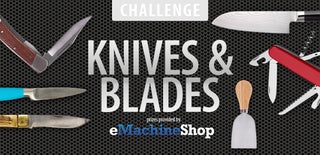Introduction: Mini Cleaver Build
Want to know how to build a mini cleaver to brave the kitchen and much more. This instructable is a step by step guide on how to do that with basic materials and tools. If I as a 13 year old boy can do it, so can you.
Step 1: Materials and Tools
Firstly, you'll need to know what tools and materials you'll need for this project.
Materials-
1. 5mm thick carbon steel
2. 2mm brass rod
3. Red oak for the handle
4. Epoxy resin
Tools-
1. Some sort of drilling machine (I used a drill press)
2. Something to cut and shape the steel:angle grinder, band-saw or hacksaw etc.
3. A small forge or blow torch to harden the knife
4. Various grits of sandpaper
5. Belt sander or linisher (I used homemade linisher, but you can even do it by hand)
6. Sharpening stone
Step 2: Shaping of the Blade
The first thing that needs to be done is to design the blade shape. The best way to do this is to first design it on a paper sheet. Once you have finalised the design trace the outline using a thin marking pen, then cut the design out and paste it onto your piece of steel. Then take the cutting tool of your choice to carefully grind or cut around your template. This can be done with a multitude of different tools, powered or hand. Once you have the rough shape of your blade use a file, sandpaper, belt grinder or an angle grinder to shape it exactly to your marked line.
Step 3: Drilling the Holes
Once your blade has been shaped, it is time to drill your holes. The the smaller holes in the handle portion are 3.5mm, they are used for attaching to the handle to the blade. The larger 10mm hole is traditionally there to hang the cleaver up on a meat hook or on the butchers belt. NOTE: All holes were chamfered with a countersink bit.
Step 4: Bevelling the Blade
In my opinion, bevelling the blade is the hardest part. For this section there are multiple tools that could be used, such as files, angle grinder, belt grinder etc. In my case I used a homemade belt grinder in order to speed up the process. Getting nice straight bevel lines really improves the aesthetics of the blade.
Step 5: Heat Treating
The blade needs to be hardened before use otherwise it will not hold an edge. In order to heat treat you will need to quench the blade in either oil or water once you have heated it up to reach a non magnetic temperature. This can be done many different ways, a charcoal forge can work, a MAPP gas torch (NOTE, a propane torch will not reach the right temperature) or a Gas or Coal forge. Once the hardening is completed it will be extremely brittle, so put it an oven at 400 degrees celsius for 2 hours to temper it.This allows the metal not to be to brittle but hard enough to keep an edge.
Step 6: Sanding
Use different grits of sandpaper to slowly get rid of the scratches in the blade. When you are sanding remember to sand in different directions for every grit so you can tell if there are any scratches from the lower grit. Work your way up to 800 grit for a smooth satin finish.
Step 7: Preparing the Handle Scales
For the handle I used red oak, there are may other materials you can use but that's what I had on hand. But before gluing, wrap the blade with tape to prevent any scratches on your polished blade. I used a bandsaw to resaw the wood into usable slabs. Mark the holes already in the knife onto the wood and use a drill to drill out the holes to fit the pins.
Step 8: Glueing
Use epoxy resin to glue your handle scales to the blade. Once it has cured use different wood working tools to bring down the wood till it's flush with the blade. Smooth it all out with your sandpaper to give it a nice smooth shape in your hand.
Step 9: Finishing
With your choice of finish, apply it to the handle to bring out the grain. Use a sharpening stone to put the final edge on and you're done. Your mini cleaver is ready for action!!!

Runner Up in the
Knives and Blades Challenge









